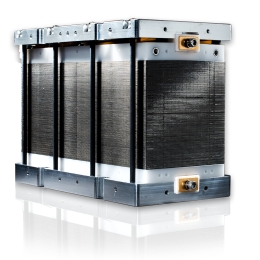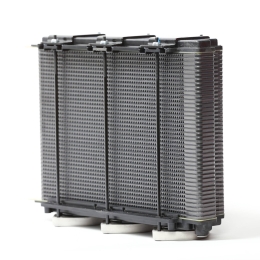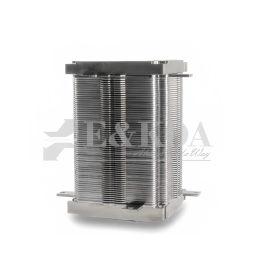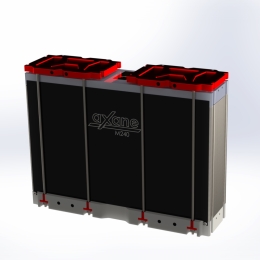- What is a fuel cell stack?
- Interfaces of a fuel cell stack to other components
- Fuel cell stack components
- Fuel cell stack technology
- Performance criteria in fuel cell stack design
- The seven technical attributes for fuel cell stack selection
- Fuel cell stacking
- Fuel cell stack efficiency
- Operating principles to be optimized
- Safety measures
- Preventing the degradation of fuel cell stacks
- Fuel cell stack testing equipment
- Kick-starting a hydrogen fuel cell stack using an integrated battery
Browse fuel cell stacks from leading suppliers on our marketplace!
What is a fuel cell stack?
In essence, fuel cell stack is a modular assembly of individual standardized fuel cells integrated into a stack assembly producing the required power output for the given application. Fuel cell stack technology encompasses all methods and components needed to integrate the individual fuel cells into the stack, thereby creating a “turn-key” and “bolt-in” fuel cell system able to be integrated into a variety of stationary and mobile applications.
In elaborating the fuel cell stack definition into more detail, hydrogen fuel cell stacks consist of a series of fuel cells that are connected in parallel or series to create the desired voltage and current output. Each fuel cell in a stack consists of two electrodes – a cathode and an anode – separated by an electrolyte. The cathode is typically made of a porous, conductive material such as carbon, while the anode is made of a material that is catalytically active, such as platinum or palladium. The electrolyte is a solid or liquid material that allows ions to pass through it but blocks electrons.
When fuel and oxidant are supplied to the anode and cathode, respectively, a chemical reaction occurs at the electrodes, producing electricity. At the anode, the fuel (typically hydrogen) is oxidized, releasing electrons and protons. The protons pass through the electrolyte to the cathode, while the electrons are forced to flow through an external circuit, producing electricity. At the cathode, the protons and electrons are recombined with oxygen from the air to form water, completing the electrochemical process.
Interfaces of a fuel cell stack to other components
There are four interfaces between a hydrogen fuel cell stack and other components of a fuel cell system. These four interfaces are:
- The fuel inlet and outlet allow hydrogen fuel to be supplied to and removed from the fuel cell stack. The fuel inlet is typically connected to a fuel supply system, which may include a compressor, filter, and storage tank. The fuel outlet is typically connected to a fuel exhaust system, which may include a gas purification unit and a stack scrubber to remove impurities and excess water.
- The oxidant inlet and outlet allow oxidant (typically air or oxygen) to be supplied to and removed from the hydrogen fuel cell stack. The oxidant inlet is typically connected to an air supply system, which may include a compressor and filter. The oxidant outlet is typically connected to an exhaust system, which may include a gas purification unit and a stack scrubber to remove impurities and excess water.
- The coolant inlet and outlet allow a cooling fluid (typically water or glycol) to be circulated through the fuel cell stack to remove heat generated during the electrochemical process. The coolant inlet is typically connected to a cooling system, which may include a pump, heat exchanger, and radiator. The coolant outlet is typically connected to a return line that leads back to the cooling system.
- The electrical interface allows the hydrogen fuel cell stack to be connected to an external load or energy storage system. The electrical interface may include connectors and cables for DC power, as well as inverters and control electronics for AC power.
Fuel cell stack components
A typical fuel cell stack includes these 7 components.
- Fuel cells are the heart of the fuel cell stack, and are responsible for generating electricity through the electrochemical process. Each fuel cell consists of an anode, cathode, and electrolyte, as well as current collectors and separators, to facilitate the flow of ions and electrons.
- The bipolar plates are thin, flat plates that are sandwiched between the fuel cells in a hydrogen fuel cell stack. They serve as the structural backbone of the stack, as well as providing electrical conductivity and thermal management. Bipolar plates may be made of a variety of materials, including metals, polymers, and ceramics.
- Gaskets and seals are used to create a hermetic seal between the fuel cells and bipolar plates in a fuel cell stack, preventing leaks and maintaining a constant gas flow. Gaskets and seals may be made of a variety of materials, including elastomers, graphite, and composite materials.
- The end plates are located at the top and bottom of the fuel cell stack, and provide structural support and sealing for the stack. They may also include provisions for fuel inlets and outlets, oxidant inlets and outlets, and coolant inlets and outlets.
- Gas manifolds are channels or pipes that distribute fuel and oxidant to the fuel cells in a hydrogen fuel cell stack. They may also include provisions for gas purification and moisture removal.
- Coolant manifolds are channels or pipes that circulate cooling fluid through the stack to remove heat. They may also include provisions for temperature sensing and control.
- Electrical connectors and cables provide an interface between the fuel cell stack and external loads or energy storage systems. They may include connectors and cables for DC power, as well as inverters and control electronics for AC power.
Fuel cell stack technology
Fuel stack technologies are available in different types such as PEM fuel cells, SOFCs, PAFCs, AFCs, MCFCs, DMFCs and ZAFCs.
- Polymer electrolyte membrane (PEM) fuel cells: in the cells of a PEM fuel cell stack, a thin polymer membrane is used as the electrolyte and these are typically fueled by hydrogen gas. The PEMFC stack design is known for high power density and fast response times and often used in portable and mobile applications.
- Solid oxide fuel cells (SOFCs): SOFCs use a solid oxide material as the electrolyte and can be fueled by a variety of gases including hydrogen, natural gas, and biogas. A solid oxide fuel cell stack offers a high degree of efficiency and durability and this design is often used in stationary power applications.
- Phosphoric acid fuel cells (PAFCs): PAFCs use phosphoric acid as the electrolyte and are typically fueled by hydrogen gas. They are known for their high efficiency and relatively low cost and are often used in stationary power applications.
- Alkaline fuel cells (AFCs): AFCs use an alkaline solution as the electrolyte and are typically fueled by hydrogen gas. They are known for their high efficiency and reliability and are often used in spacecraft and other specialized applications.
- Molten carbonate fuel cells (MCFCs): MCFCs use a molten carbonate material as the electrolyte and can be fueled by a variety of gases including hydrogen, natural gas, and biogas. They are known for their high efficiency and fuel flexibility and are often used in stationary power applications.
- Direct methanol fuel cells (DMFCs): DMFCs use a proton exchange membrane as the electrolyte and are fueled by methanol dissolved in water. They are known for their high power density and fast response times and are often used in portable and mobile applications.
- Zinc-air fuel cells: Zinc-air fuel cells use oxygen from the air as the oxidant and are fueled by zinc. They are known for their high energy density and low cost and are often used in portable and mobile applications.
Performance criteria in fuel cell stack design
Power density, efficiency, durability and cost are 4 important performance criteria’s that are required for a state-of-the-art hydrogen fuel cell stack.
- Power density refers to the amount of power that can be generated per unit area or volume of a fuel cell stack. Higher power densities allow for smaller, more compact stacks, which are important for applications with limited space.
- Efficiency refers to the ratio of electrical energy output to chemical energy input in a fuel cell stack. Higher efficiencies result in less wasted energy and lower fuel consumption.
- Durability refers to the ability of a fuel cell stack to maintain its performance over time. Factors that can impact durability include the quality and purity of the fuel and oxidant, the operating temperature and humidity, and the presence of impurities and contaminants.
- Cost is an important consideration in fuel cell stack design. Factors that can impact the cost of a fuel cell stack include the materials and manufacturing processes used, as well as the scale of production.
The seven technical attributes for fuel cell stack selection
The seven technical attributes that are typically considered when purchasing and integrating a fuel cell stack in a fuel cell system are mentioned below.
- Type of fuel is one of the most important technical attribute of a fuel cell stack. Different fuel cell technologies are designed to operate on different fuels, and it is important to choose a fuel cell stack that is compatible with the fuel that will be used. For example, PEM fuel cell stacks are typically used with hydrogen, while direct methanol fuel cell (DMFC) stacks are designed to operate on methanol.
- The stack operating temperature is an important consideration, as it impacts efficiency and durability of the fuel cell stack assembly. Some fuel cell technologies, such as proton exchange membrane (PEM) fuel cells, are sensitive to temperature. The PEM fuel cell stack design therefore requires precise temperature control for optimum operation. Other designs, such as the SOFC stack (solid oxide fuel cell – SOFC) design, can operate at much higher temperatures and may not require as much temperature control.
- The stack operating pressure is another important consideration, as it can impact the efficiency and durability of the stack. Some fuel cell technologies, such as PEM fuel cells, operate at low pressures and require precise pressure control of the PEM fuel cell stack assembly to operate optimally. Others, such as SOFCs, can operate at much higher pressures and may not require as much pressure control.
- Power output of a fuel cell stack is an important consideration, as it determines the amount of electricity that can be generated by the stack. The stack power output can be adjusted by changing the number of fuel cells in the stack assenbly, the size of the fuel cells, or the operating conditions of the stack.
- Voltage and current output of a fuel cell stack are important considerations, as they determine the compatibility of the stack with external loads or energy storage systems. The voltage and current output can be adjusted by connecting the fuel cells in series or parallel, or by using voltage and current regulation electronics.
- Size and weight of a hydrogen fuel cell stack are important considerations, as they determine the physical footprint and transportability of the stack. Smaller and lighter fuel cell stacks are generally more desirable for applications with limited space or mobility requirements.
- The ease of integration of a fuel cell stack is an important consideration. This determines how easily the stack can be incorporated into a fuel cell system. Factors that can impact the ease of integration include the number and type of interfaces, the compatibility with other components, and the availability of documentation and technical support.
Fuel cell stacking
The power of a hydrogen fuel cell stack can be increased by stacking more fuel cells in a fuel cell stack assembly. This is because each fuel cell in a stack contributes to the overall power output of the stack and adding more fuel cells increases the total power output. Stacking of fuel cells allows for greater flexibility in the design of a fuel cell system. The modularity inherent to fuel cell stack design allows for power output to be easily adjusted by adding or removing fuel cells as needed. So the fuel cell system can be tailored to the specific power requirements of the application and it is easier to scale the system up or down using identical components.
In addition to increasing the power output, stacking fuel cells in a modular fashion also allows for a more compact and lightweight design, as more power can be generated in a smaller volume. This is particularly important for applications with limited space or weight constraints, such as portable devices or vehicles.
Fuel cell stack efficiency
Stack efficiency is typically measured as the ratio of electrical energy output to chemical energy input. This is calculated by measuring and comparing the electrical power output of the stack, as well as the flow rate and energy content of the fuel and oxidant inputs.
The efficiency of a fuel cell stack can vary depending on a number of factors, including the fuel cell stack technology, the operating conditions of the stack, and the quality and purity of the fuel and oxidant. In general, hydrogen fuel cell stacks are most efficient when operating at their rated power output and at optimal temperatures and pressures.
Operating principles to be optimized
A fuel cell engineer is typically focused on optimizing the performance and efficiency of a hydrogen fuel cell stack as well as its durability and reliability. To achieve this, the engineer will focus on a number of operating principles, such as:
- Fuel and oxidant purity: Ensuring that the fuel and oxidant gases are of high purity can help to minimize degradation and extend the lifetime of the fuel cell stack. The engineer may use tools such as gas purification units, filters, and moisture traps to remove impurities and contaminants from the gases.
- Operating temperature and pressure: Maintaining optimal operating temperature and pressure can help to maximize the efficiency and durability of the stack. The engineer may use tools such as thermocouples, temperature sensors, and pressure sensors to monitor and control the operating conditions of the stack.
- Load management: Managing the load on the fuel cell stack can help to optimize its performance and extend its lifetime. The engineer may use tools such as load banks, data acquisition systems, and control electronics to monitor and control the load on the stack.
- Maintenance: Regular maintenance can help to prevent degradation and extend the lifetime of the stack. The engineer may use tools such as cleaning supplies, inspection equipment, and diagnostic tools to perform maintenance on the stack.
- Testing: Regular testing helps to identify any issues or problems that may arise and allow the engineer to take corrective action as needed. The engineer may use tools such as fuel cell test stands, load banks, and data acquisition systems to test the performance and reliability of the stack.
In addition to these operating principles, a fuel cell engineer may also use a range of tools and equipment to optimize the performance and reliability of a hydrogen fuel cell stack. These tools may include:
- Computational tools: Fuel cell engineers may use computational tools, such as computer-aided design (CAD) software and simulation tools, to design and optimize the fuel cell stack and its components. These tools can help to identify potential design issues and allow the engineer to make changes and improvements before the stack is built.
- Data analysis tools: Fuel cell engineers may use data analysis tools, such as spreadsheets and data visualization software, to analyze data from fuel cell tests and identify trends and patterns. This can help the engineer to understand the performance and reliability of the hydrogen fuel cell stack and identify areas for improvement.
- Diagnostic equipment: Fuel cell engineers may use diagnostic equipment, such as multimeters and oscilloscopes, to troubleshoot and diagnose problems with the fuel cell stack. These tools can help the engineer to identify issues with the stack and take corrective action as needed.
- Test equipment: To test performance and reliability, engineers may use a range of equipment for fuel cell stack testing, such as load banks, data acquisition systems, and fuel cell test stands. These tools can help the engineer to identify problems and take corrective action as needed.
Safety measures
There are several safety measures that are typically taken in the design of fuel cell systems to ensure that hydrogen fuel cell stacks operate safely.
- Gas handling and purification: Fuel cell systems typically include a range of measures to ensure that the fuel and oxidant gases are handled and purified safely. This may include filters to remove contaminants and impurities, compressors and regulators to control the gas flow and pressure, and gas purification units to remove moisture and other impurities.
- Cooling systems: Fuel cell stacks generate heat during the electrochemical process, and it is important to ensure that the stacks are cooled properly to prevent overheating and damage. Fuel cell systems typically include a cooling system to circulate a cooling fluid through the stacks and remove excess heat.
- Electrical safety: Fuel cell systems generate electricity, and it is important to ensure that the electrical components of the system are designed and installed safely. This may include measures such as grounding, overcurrent protection, and insulation to prevent electrical fires and shocks.
- Structural integrity: Fuel cell stacks are typically subjected to a range of environmental and mechanical stresses, and it is important to ensure that the stacks are designed and constructed with sufficient structural integrity to withstand these stresses. This may include measures such as reinforcement, bracing, and protective coatings to prevent damage.
- Emergency shutdown: Fuel cell systems typically include an emergency shutdown system to automatically shut down the system in the event of a fault or malfunction. This may include sensors to detect hazardous conditions, as well as control electronics to trigger the shutdown.
Preventing the degradation of fuel cell stacks
Degradation of a fuel cell stack effects the lifetime of a fuel cell, but several measures can be used to reduce fuel cell stack degradation and increase their life.
- Proper filtration of the fuel and oxidant gases can help to remove impurities and contaminants that can cause degradation of the fuel cells. This may include filters to remove particulates, as well as gas purification units to remove moisture and other impurities.
- The purity of the hydrogen fuel can also impact the performance and lifetime of a fuel cell stack. Hydrogen fuel that is contaminated with impurities such as water vapour, hydrocarbons, or metals can cause corrosion and degradation of the fuel cells. It is important to ensure that the hydrogen fuel is of high purity to minimize these effects.
- The operating conditions of a hydrogen fuel cell stack can also impact its performance and lifetime. Factors such as temperature, pressure, and humidity can all affect the stability and durability of the fuel cells. It is important to maintain optimal operating conditions to minimize degradation and extend the lifetime of the stack.
- Proper stack maintenance can also help to prevent degradation and extend its lifetime. This may include measures such as regular cleaning and inspection of the fuel cells and other components, as well as replacing worn, or damaged parts as needed.
Fuel cell stack testing equipment
Several pieces of equipment such as gas flow meters, thermocouples, load banks, data acquisition systems and fuel cell test stands are commonly used to test hydrogen fuel cell stacks.
- Gas flow meters and regulators are used to measure and control the flow rate of the fuel and oxidant gases to the fuel cell stack. This allows the operating conditions of the stack to be precisely controlled and measured.
- Thermocouples and temperature sensors are used to measure the temperature of the stack and its components, such as the fuel cells, bipolar plates, and coolant. This allows the temperature profile of the stack to be monitored and controlled.
- Load banks are used to apply a load to a fuel cell stack assembly and measure its electrical output. This allows the performance of the stack to be characterized under different load conditions.
- Data acquisition systems are used to collect and record data from the fuel cell stack and its components during testing. This may include data on the electrical output, gas flow rates, temperature, and other parameters.
- Fuel cell test stands are specialized systems that are used for testing stacks under a variety of conditions. These systems may include features such as temperature and humidity control, gas flow and pressure control, load banks, and data acquisition systems. Fuel cell test stands are typically used to characterize the performance of hydrogen fuel cell stacks, as well as to test the durability and reliability of the stacks under different operating conditions.
Kick-starting a hydrogen fuel cell stack using an integrated battery
An integrated battery in a fuel cell system can be used to expand its lifetime in several ways. One way is by using the battery to “kick-start” the fuel cell stack, particularly in situations where the stack is cold or has been idle for an extended period of time. In this case, the battery can provide a temporary power boost to get the stack up and running, until it takes over as the primary power source once it has reached operating temperature.
An integrated battery can also be used to provide a source of backup power for the fuel cell system in the event of a power outage or other interruption in the fuel supply. In this case, the battery can provide power to critical loads until the stack assembly can be restarted or the fuel supply is restored.
Another way that an integrated battery can be used to extend the lifetime of a fuel cell system is by “shaving” the load on the fuel cell stack. This involves using the battery to store excess power generated during times of high demand, and then discharging that power back to the load during times of lower demand. This can help to reduce the overall load on the hydrogen fuel cell stack, which can in turn extend its lifetime.
Last update: 06.02.2023







